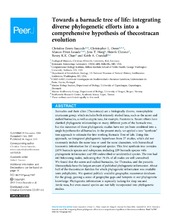| dc.contributor.author | Ewers-Saucedo, Christine | |
| dc.contributor.author | Owen, Christopher L | |
| dc.contributor.author | Perez-Losada, Marcos | |
| dc.contributor.author | Høeg, Jens T. | |
| dc.contributor.author | Glenner, Henrik | |
| dc.contributor.author | Chan, Benny K.K. | |
| dc.contributor.author | Crandall, Keith A. | |
| dc.date.accessioned | 2020-04-02T11:40:50Z | |
| dc.date.available | 2020-04-02T11:40:50Z | |
| dc.date.issued | 2019-08-16 | |
| dc.Published | Ewers-Saucedo C, Owen CL, Perez-Losada M, Høeg JT, Glenner H, Chan BKK, Crandall KA. Towards a barnacle tree of life: Integrating diverse phylogenetic efforts into a comprehensive hypothesis of thecostracan evolution. PeerJ. 2019;7:e7387 | eng |
| dc.identifier.issn | 2167-8359 | en_US |
| dc.identifier.uri | http://hdl.handle.net/1956/21665 | |
| dc.description.abstract | Barnacles and their allies (Thecostraca) are a biologically diverse, monophyletic crustacean group, which includes both intensely studied taxa, such as the acorn and stalked barnacles, as well as cryptic taxa, for example, Facetotecta. Recent efforts have clarified phylogenetic relationships in many different parts of the barnacle tree, but the outcomes of these phylogenetic studies have not yet been combined into a single hypothesis for all barnacles. In the present study, we applied a new “synthesis” tree approach to estimate the first working Barnacle Tree of Life. Using this approach, we integrated phylogenetic hypotheses from 27 studies, which did not necessarily include the same taxa or used the same characters, with hierarchical taxonomic information for all recognized species. This first synthesis tree contains 2,070 barnacle species and subspecies, including 239 barnacle species with phylogenetic information and 198 undescribed or unidentified species. The tree had 442 bifurcating nodes, indicating that 79.3% of all nodes are still unresolved. We found that the acorn and stalked barnacles, the Thoracica, and the parasitic Rhizocephala have the largest amount of published phylogenetic information. About half of the thecostracan families for which phylogenetic information was available were polyphyletic. We queried publicly available geographic occurrence databases for the group, gaining a sense of geographic gaps and hotspots in our phylogenetic knowledge. Phylogenetic information is especially lacking for deep sea and Arctic taxa, but even coastal species are not fully incorporated into phylogenetic studies. | en_US |
| dc.language.iso | eng | eng |
| dc.publisher | PeerJ | en_US |
| dc.rights | Attribution CC BY | eng |
| dc.rights.uri | https://creativecommons.org/licenses/by/4.0/ | eng |
| dc.subject | Barnacles | eng |
| dc.subject | Thecostraca | eng |
| dc.subject | Synthesis tree | eng |
| dc.subject | Open tree of life | eng |
| dc.subject | Phylogenetic studies | eng |
| dc.subject | Taxonomy | eng |
| dc.subject | Morphology | eng |
| dc.title | Towards a barnacle tree of life: Integrating diverse phylogenetic efforts into a comprehensive hypothesis of thecostracan evolution | en_US |
| dc.type | Peer reviewed | |
| dc.type | Journal article | |
| dc.date.updated | 2020-01-14T18:45:55Z | |
| dc.description.version | publishedVersion | en_US |
| dc.rights.holder | Copyright 2019 The Author(s) | en_US |
| dc.identifier.doi | https://doi.org/10.7717/peerj.7387 | |
| dc.identifier.cristin | 1764553 | |
| dc.source.journal | PeerJ | |

